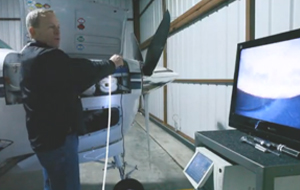Anatomy of a Valve Failure
The View Through The Borescope: Diagnosing Valve Problems
Modern borescopes are fantastic tools for determining the health of piston engines, and they give us the unprecedented ability to make and share digital images of the things we see inside cylinders.
After closely examining hundreds of aircraft engines and thousands of cylinders, some trends become clear.
First, the keys to exhaust valve longevity are: Precise contact between the valve face and the valve seat, and a good fit between the valve stem and the valve guide. In flight, the pilot must keep cylinder head temperatures within normal limits to avoid damage. 
Exhaust valves burn when they fail to seat properly and, as a result, can’t efficiently transfer heat to the cylinder. Ultra-hot gasses scorch these valves beginning at their thin rims. This damage erodes and weakens the valves, exacerbates the poor seating problem, and dramatically accelerates wear. Without intervention, exhaust valve can fail with potentially disastrous consequences.
Determining Valve Health
The first sign of a healthy valve is a symmetrical pattern on the valve face. 
Unburned byproducts of combustion frequently leave red or orange deposits on the valve face. These colorful buildups tend to be thickest at the center of the valve (where the temperature is relatively cool). The cooler the valve, and the richer the fuel/air mixture, the thicker the deposits are going to be.
Don’t be alarmed by the reddish color of these buildups. As long as the pattern is symmetrical and resembles an overcooked pizza, it’s probably healthy.
Green Means Stop
When an exhaust valve doesn’t seat properly, ultra-hot gasses can leak around the thin valve rim and create hot spots. The first indication of a problem is usually an asymmetric pattern of deposits on the valve face. 
Normal buildups on the valve face tend to be red, orange, or gray in color. The valve face can turn yellow or green when the temperature becomes abnormally high. When a portion of the exhaust valve itself turns green, it means the valve is severely burned and weakened, and the valve should be replaced immediately. In this case, “Green means stop.”
The green pattern is usually crescent-shaped and expands from the edge to the center of the valve. In advanced cases, two crescent patterns may emerge on opposite edges of the valve.
Valve Rotation
Exhaust valves are designed to rotate, and this rotation is essential to valve longevity since it helps prevent deposits from building up around the seat, stem, and guide. At a typical 2,400-rpm cruise, each exhaust valve opens and closes 1,200 times a minute, and each valve rotates once per minute.
Precise alignment of the rocker arm is essential for proper valve rotation. A poorly aligned rocker arm can wear out a valve guide within 100 hours of engine operation – and that wear can cause improper valve seating, hot spots, and valve damage or failure. Watch through the borescope as you turn the propeller by hand and pay careful attention to how the exhaust valve opens and closes. Note any “side step.” The more a valve shifts sideways as it enters the seat, the more worn the valve guide is likely to be.
Also, when you find a burned valve, make sure to closely inspect the rocker arm. If the toe of the rocker arm isn’t striking the valve squarely, it will cause valve guide wear, and the valve to seat improperly. A poorly aligned rocker arm can prevent the new valve from rotating properly and result in premature valve wear.
Traditional cylinder compression checks are still valuable diagnostic tools. Low readings on a compression test, and the sound of air leaking from the exhaust, are obvious warning signs of valve problems. Combine this information with the clear and colorful images you can see through a modern borescope and you will gain a much fuller picture of an engine’s condition. -By Adrian Eichhorn

Adrian Eichhorn, JetBlue Airways first officer, Beechcraft Bonanza and Baron maintenance and flight instruction
ATP, CFII, MEI, A&P-IA, 13,000+ hours
To learn more, download the poster below
 Burnt exhaust valves have long been a leading cause of cylinder failures and power loss in piston aicraft engines. Modern borescopes allow us to look deep inside cylinders--and this guide will help you interpret what you see through the viewfinder.
Burnt exhaust valves have long been a leading cause of cylinder failures and power loss in piston aicraft engines. Modern borescopes allow us to look deep inside cylinders--and this guide will help you interpret what you see through the viewfinder.